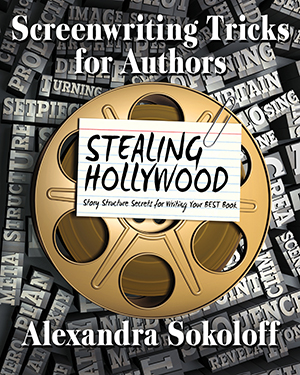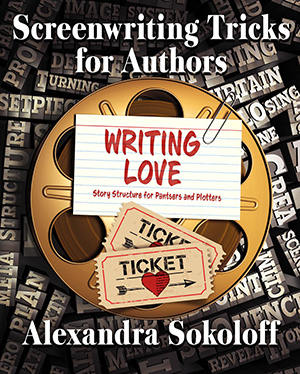When people ask, “Where do you get your ideas?”, authors tend to clam up or worse, get sarcastic – because the only real answer to that is, “Where DON’T I get ideas?” or even more to the point, “How do I turn these ideas OFF?”
The thing is, “Where do you get your ideas?” is not the real question these people are asking. The real question is “How do you go from an idea to a coherent story line that holds up—and holds a reader’s interest—for 400 pages of a book?”
Or more concisely: “How do you come up with your PREMISES?”
Look, we all have story ideas all the time. Even non-writers, and non-aspiring writers – I truly mean, EVERYONE, has story ideas all the time. Those story ideas are called daydreams, or fantasies, or often “Porn starring me and Benedict Cumberbatch, or me and Idris Elba.” (Or maybe both. Wrap your mind around that one for a second…)
But you see what I mean.
We all create stories in our own heads all the time, minimal as some of our plot lines may be.
So I bet you have dozens of ideas, hundreds. A better question is “What’s a good story idea?”
I see two essential ingredients:
A) What idea gets you excited enough to spend a year (or most likely more) of your life completely immersed in it?
and
B) Gets other people excited enough about it to buy it and read it and even maybe possibly make it into a movie or TV series with an amusement park ride spinoff and a Guess clothing line based on the story?
A) is good if you just want to write for yourself.
But B) is essential if you want to be a professional writer.
As many of you know, I’m all about learning by making lists. Because let’s face it—we have to trick ourselves into writing, every single day, and what could be simpler and more non-threatening than making a list? Anything to avoid the actual rest of it!
So here are two lists to do to get those ideas flowing, and then we can start to narrow it all down to the best one.
List # 1: Make a list of all your story ideas.
Yes, you read that right. ALL of them.
This is a great exercise because it gets your subconscious churning and invites it to choose what it truly wants to be working on. Your subconscious knows WAY more than you do about writing. None of us can do the kind of deep work that writing is all on our own. And with a little help from the Universe you could find yourself writing the next Harry Potter or Twilight.
Also this exercise gives you an overall idea of what your THEMES are as a writer (and very likely the themes you have as a person). I absolutely believe that writers only have about six or seven themes that they’re dealing with over and over and over again. It’s my experience that your writing improves exponentially when you become more aware of the themes that you’re working with.
You may be amazed, looking over this list that you’ve generated, how much overlap there is in theme (and in central characters, hero/ines and villains, and dynamics between characters, and tone of endings).
You may even find that two of your story ideas, or a premise line plus a character from a totally different premise line, might combine to form a bigger, more exciting idea. That certainly happened to me with my Huntress Moon series. Random characters I’d always meant to write about suddenly fit perfectly into the new series. It was magic.
But in any case, you should have a much better idea at the end of the exercise of what turns you on as a writer, and what would sustain you emotionally over the long process of writing a novel.
Then just let that percolate for a while. Give yourself a little time for the right idea to take hold of you. You’ll know what that feels like – it’s a little like falling in love.
List # 2: The Master List
The other list I use in all my workshops and workbooks is a Master List: a list of your ten favorite movies and books in the genre that you’re writing. Or if you don’t have a premise yet, ten movies and books that you WISH you had written.
It’s good to compare and contrast your idea list with this ideal list.
This list of ten (or more, if you want—ten is just a minimum!) – is going to be enormously helpful to you in structuring and outlining your own novel.
Now, the novelists who have just found this blog recently may be wondering why I’m asking you to list movies as well as books. Good question.
The thing is, for the purposes of structural analysis, film is such a compressed and concise medium that it’s like seeing an X-ray of a story. In film you have two hours, really a little less, to tell the story. It’s a very stripped-down form that even so, often has enormous emotional power. Plus we’ve usually seen more of these movies than we’ve read specific books, so they’re a more universal form of reference for discussion.
It’s often easier to see the mechanics of structure in a film than in a novel, which makes looking at films that are similar to your own novel story a great way to jump start your novel outline.
And just practically, film has had an enormous influence on contemporary novels, and on publishing. Editors love books with the high concept premises, pacing, and visual and emotional impact of movies, so being aware of classic and blockbuster films and the film techniques that got them that status can help you write novels that will actually sell in today’s market.
And even beyond that – studying movies is fun, and fun is something writers just don’t let themselves have enough of. If you train yourself to view movies looking for for some of these structural elements I’m going to be talking about, then every time you go to the movies or watch something on television, you’re actually honing your craft (even on a date or while spending quality time with your loved ones!), and after a while you won’t even notice you’re doing it.
When the work is play, you’ve got the best of all possible worlds..
So of course I’d love to hear: What personal themes did you discover as you did this brainstorming?
—Alex




